Minghui Fang
Continual Cross-Modal Generalization
Apr 01, 2025Abstract:Cross-modal generalization aims to learn a shared discrete representation space from multimodal pairs, enabling knowledge transfer across unannotated modalities. However, achieving a unified representation for all modality pairs requires extensive paired data, which is often impractical. Inspired by the availability of abundant bimodal data (e.g., in ImageBind), we explore a continual learning approach that incrementally maps new modalities into a shared discrete codebook via a mediator modality. We propose the Continual Mixture of Experts Adapter (CMoE-Adapter) to project diverse modalities into a unified space while preserving prior knowledge. To align semantics across stages, we introduce a Pseudo-Modality Replay (PMR) mechanism with a dynamically expanding codebook, enabling the model to adaptively incorporate new modalities using learned ones as guidance. Extensive experiments on image-text, audio-text, video-text, and speech-text show that our method achieves strong performance on various cross-modal generalization tasks. Code is provided in the supplementary material.
Enhancing Expressive Voice Conversion with Discrete Pitch-Conditioned Flow Matching Model
Feb 08, 2025



Abstract:This paper introduces PFlow-VC, a conditional flow matching voice conversion model that leverages fine-grained discrete pitch tokens and target speaker prompt information for expressive voice conversion (VC). Previous VC works primarily focus on speaker conversion, with further exploration needed in enhancing expressiveness (such as prosody and emotion) for timbre conversion. Unlike previous methods, we adopt a simple and efficient approach to enhance the style expressiveness of voice conversion models. Specifically, we pretrain a self-supervised pitch VQVAE model to discretize speaker-irrelevant pitch information and leverage a masked pitch-conditioned flow matching model for Mel-spectrogram synthesis, which provides in-context pitch modeling capabilities for the speaker conversion model, effectively improving the voice style transfer capacity. Additionally, we improve timbre similarity by combining global timbre embeddings with time-varying timbre tokens. Experiments on unseen LibriTTS test-clean and emotional speech dataset ESD show the superiority of the PFlow-VC model in both timbre conversion and style transfer. Audio samples are available on the demo page https://speechai-demo.github.io/PFlow-VC/.
OmniChat: Enhancing Spoken Dialogue Systems with Scalable Synthetic Data for Diverse Scenarios
Jan 02, 2025



Abstract:With the rapid development of large language models, researchers have created increasingly advanced spoken dialogue systems that can naturally converse with humans. However, these systems still struggle to handle the full complexity of real-world conversations, including audio events, musical contexts, and emotional expressions, mainly because current dialogue datasets are constrained in both scale and scenario diversity. In this paper, we propose leveraging synthetic data to enhance the dialogue models across diverse scenarios. We introduce ShareChatX, the first comprehensive, large-scale dataset for spoken dialogue that spans diverse scenarios. Based on this dataset, we introduce OmniChat, a multi-turn dialogue system with a heterogeneous feature fusion module, designed to optimize feature selection in different dialogue contexts. In addition, we explored critical aspects of training dialogue systems using synthetic data. Through comprehensive experimentation, we determined the ideal balance between synthetic and real data, achieving state-of-the-art results on the real-world dialogue dataset DailyTalk. We also highlight the crucial importance of synthetic data in tackling diverse, complex dialogue scenarios, especially those involving audio and music. For more details, please visit our demo page at \url{https://sharechatx.github.io/}.
Speech Watermarking with Discrete Intermediate Representations
Dec 18, 2024Abstract:Speech watermarking techniques can proactively mitigate the potential harmful consequences of instant voice cloning techniques. These techniques involve the insertion of signals into speech that are imperceptible to humans but can be detected by algorithms. Previous approaches typically embed watermark messages into continuous space. However, intuitively, embedding watermark information into robust discrete latent space can significantly improve the robustness of watermarking systems. In this paper, we propose DiscreteWM, a novel speech watermarking framework that injects watermarks into the discrete intermediate representations of speech. Specifically, we map speech into discrete latent space with a vector-quantized autoencoder and inject watermarks by changing the modular arithmetic relation of discrete IDs. To ensure the imperceptibility of watermarks, we also propose a manipulator model to select the candidate tokens for watermark embedding. Experimental results demonstrate that our framework achieves state-of-the-art performance in robustness and imperceptibility, simultaneously. Moreover, our flexible frame-wise approach can serve as an efficient solution for both voice cloning detection and information hiding. Additionally, DiscreteWM can encode 1 to 150 bits of watermark information within a 1-second speech clip, indicating its encoding capacity. Audio samples are available at https://DiscreteWM.github.io/discrete_wm.
WavChat: A Survey of Spoken Dialogue Models
Nov 26, 2024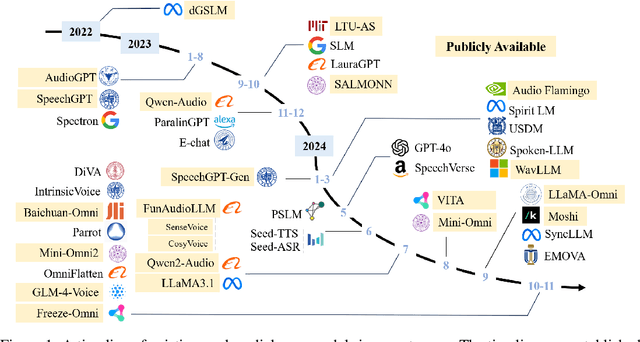

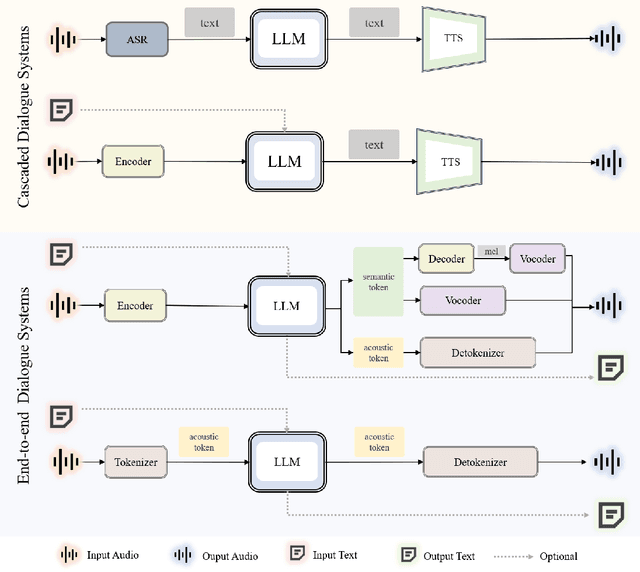
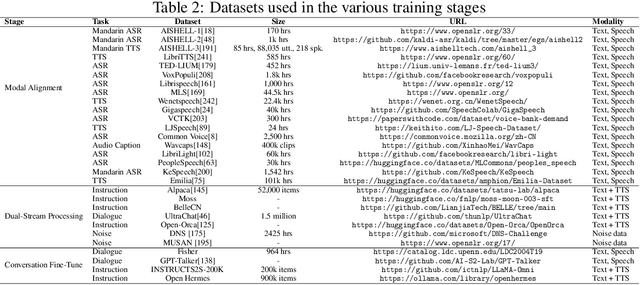
Abstract:Recent advancements in spoken dialogue models, exemplified by systems like GPT-4o, have captured significant attention in the speech domain. Compared to traditional three-tier cascaded spoken dialogue models that comprise speech recognition (ASR), large language models (LLMs), and text-to-speech (TTS), modern spoken dialogue models exhibit greater intelligence. These advanced spoken dialogue models not only comprehend audio, music, and other speech-related features, but also capture stylistic and timbral characteristics in speech. Moreover, they generate high-quality, multi-turn speech responses with low latency, enabling real-time interaction through simultaneous listening and speaking capability. Despite the progress in spoken dialogue systems, there is a lack of comprehensive surveys that systematically organize and analyze these systems and the underlying technologies. To address this, we have first compiled existing spoken dialogue systems in the chronological order and categorized them into the cascaded and end-to-end paradigms. We then provide an in-depth overview of the core technologies in spoken dialogue models, covering aspects such as speech representation, training paradigm, streaming, duplex, and interaction capabilities. Each section discusses the limitations of these technologies and outlines considerations for future research. Additionally, we present a thorough review of relevant datasets, evaluation metrics, and benchmarks from the perspectives of training and evaluating spoken dialogue systems. We hope this survey will contribute to advancing both academic research and industrial applications in the field of spoken dialogue systems. The related material is available at https://github.com/jishengpeng/WavChat.
MoMu-Diffusion: On Learning Long-Term Motion-Music Synchronization and Correspondence
Nov 04, 2024Abstract:Motion-to-music and music-to-motion have been studied separately, each attracting substantial research interest within their respective domains. The interaction between human motion and music is a reflection of advanced human intelligence, and establishing a unified relationship between them is particularly important. However, to date, there has been no work that considers them jointly to explore the modality alignment within. To bridge this gap, we propose a novel framework, termed MoMu-Diffusion, for long-term and synchronous motion-music generation. Firstly, to mitigate the huge computational costs raised by long sequences, we propose a novel Bidirectional Contrastive Rhythmic Variational Auto-Encoder (BiCoR-VAE) that extracts the modality-aligned latent representations for both motion and music inputs. Subsequently, leveraging the aligned latent spaces, we introduce a multi-modal Transformer-based diffusion model and a cross-guidance sampling strategy to enable various generation tasks, including cross-modal, multi-modal, and variable-length generation. Extensive experiments demonstrate that MoMu-Diffusion surpasses recent state-of-the-art methods both qualitatively and quantitatively, and can synthesize realistic, diverse, long-term, and beat-matched music or motion sequences. The generated samples and codes are available at https://momu-diffusion.github.io/
OmniSep: Unified Omni-Modality Sound Separation with Query-Mixup
Oct 28, 2024



Abstract:The scaling up has brought tremendous success in the fields of vision and language in recent years. When it comes to audio, however, researchers encounter a major challenge in scaling up the training data, as most natural audio contains diverse interfering signals. To address this limitation, we introduce Omni-modal Sound Separation (OmniSep), a novel framework capable of isolating clean soundtracks based on omni-modal queries, encompassing both single-modal and multi-modal composed queries. Specifically, we introduce the Query-Mixup strategy, which blends query features from different modalities during training. This enables OmniSep to optimize multiple modalities concurrently, effectively bringing all modalities under a unified framework for sound separation. We further enhance this flexibility by allowing queries to influence sound separation positively or negatively, facilitating the retention or removal of specific sounds as desired. Finally, OmniSep employs a retrieval-augmented approach known as Query-Aug, which enables open-vocabulary sound separation. Experimental evaluations on MUSIC, VGGSOUND-CLEAN+, and MUSIC-CLEAN+ datasets demonstrate effectiveness of OmniSep, achieving state-of-the-art performance in text-, image-, and audio-queried sound separation tasks. For samples and further information, please visit the demo page at \url{https://omnisep.github.io/}.
Zero-resource Hallucination Detection for Text Generation via Graph-based Contextual Knowledge Triples Modeling
Sep 18, 2024



Abstract:LLMs obtain remarkable performance but suffer from hallucinations. Most research on detecting hallucination focuses on the questions with short and concrete correct answers that are easy to check the faithfulness. Hallucination detections for text generation with open-ended answers are more challenging. Some researchers use external knowledge to detect hallucinations in generated texts, but external resources for specific scenarios are hard to access. Recent studies on detecting hallucinations in long text without external resources conduct consistency comparison among multiple sampled outputs. To handle long texts, researchers split long texts into multiple facts and individually compare the consistency of each pairs of facts. However, these methods (1) hardly achieve alignment among multiple facts; (2) overlook dependencies between multiple contextual facts. In this paper, we propose a graph-based context-aware (GCA) hallucination detection for text generations, which aligns knowledge facts and considers the dependencies between contextual knowledge triples in consistency comparison. Particularly, to align multiple facts, we conduct a triple-oriented response segmentation to extract multiple knowledge triples. To model dependencies among contextual knowledge triple (facts), we construct contextual triple into a graph and enhance triples' interactions via message passing and aggregating via RGCN. To avoid the omission of knowledge triples in long text, we conduct a LLM-based reverse verification via reconstructing the knowledge triples. Experiments show that our model enhances hallucination detection and excels all baselines.
WavTokenizer: an Efficient Acoustic Discrete Codec Tokenizer for Audio Language Modeling
Aug 29, 2024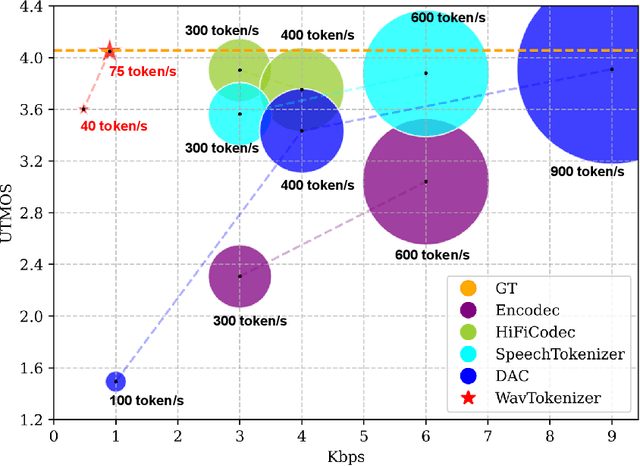
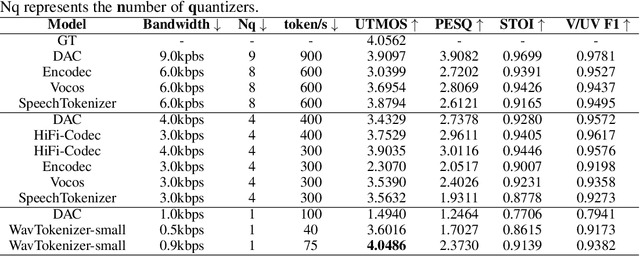

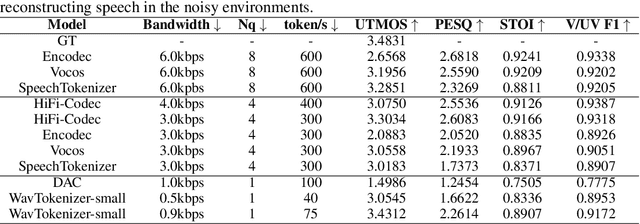
Abstract:Language models have been effectively applied to modeling natural signals, such as images, video, speech, and audio. A crucial component of these models is the codec tokenizer, which compresses high-dimensional natural signals into lower-dimensional discrete tokens. In this paper, we introduce WavTokenizer, which offers several advantages over previous SOTA acoustic codec models in the audio domain: 1)extreme compression. By compressing the layers of quantizers and the temporal dimension of the discrete codec, one-second audio of 24kHz sampling rate requires only a single quantizer with 40 or 75 tokens. 2)improved subjective quality. Despite the reduced number of tokens, WavTokenizer achieves state-of-the-art reconstruction quality with outstanding UTMOS scores and inherently contains richer semantic information. Specifically, we achieve these results by designing a broader VQ space, extended contextual windows, and improved attention networks, as well as introducing a powerful multi-scale discriminator and an inverse Fourier transform structure. We conducted extensive reconstruction experiments in the domains of speech, audio, and music. WavTokenizer exhibited strong performance across various objective and subjective metrics compared to state-of-the-art models. We also tested semantic information, VQ utilization, and adaptability to generative models. Comprehensive ablation studies confirm the necessity of each module in WavTokenizer. The related code, demos, and pre-trained models are available at https://github.com/jishengpeng/WavTokenizer.
ACE: A Generative Cross-Modal Retrieval Framework with Coarse-To-Fine Semantic Modeling
Jun 25, 2024



Abstract:Generative retrieval, which has demonstrated effectiveness in text-to-text retrieval, utilizes a sequence-to-sequence model to directly generate candidate identifiers based on natural language queries. Without explicitly computing the similarity between queries and candidates, generative retrieval surpasses dual-tower models in both speed and accuracy on large-scale corpora, providing new insights for cross-modal retrieval. However, constructing identifiers for multimodal data remains an untapped problem, and the modality gap between natural language queries and multimodal candidates hinders retrieval performance due to the absence of additional encoders. To this end, we propose a pioneering generAtive Cross-modal rEtrieval framework (ACE), which is a comprehensive framework for end-to-end cross-modal retrieval based on coarse-to-fine semantic modeling. We propose combining K-Means and RQ-VAE to construct coarse and fine tokens, serving as identifiers for multimodal data. Correspondingly, we design the coarse-to-fine feature fusion strategy to efficiently align natural language queries and candidate identifiers. ACE is the first work to comprehensively demonstrate the feasibility of generative approach on text-to-image/audio/video retrieval, challenging the dominance of the embedding-based dual-tower architecture. Extensive experiments show that ACE achieves state-of-the-art performance in cross-modal retrieval and outperforms the strong baselines on Recall@1 by 15.27% on average.
 Add to Chrome
Add to Chrome Add to Firefox
Add to Firefox Add to Edge
Add to Edge